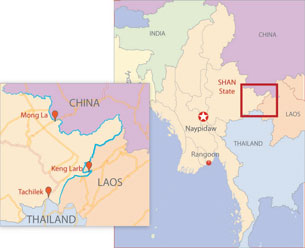




Years of armed ethnic conflict in Burma along the border with China, India, and Thailand are taking a deadly toll on an innocent bystander: the big cat.
Armed groups in these "self-governed' conflict-ridden areas not only smuggle arms, narcotics, and humans but also tigers and leopards and their brutally cut up parts to beef up their war chest, according to wildlife conservationists.
These areas have in fact turned into an international nerve center of the illict big cat trade, involving mostly tigers, said a 10-year study by TRAFFIC, the wildlife trade monitoring network,
Much of the trade occurs in areas between northern Burma and southern China as the armed conflict between the minority ethnic groups and Burma's ruling military junta hinders coordination of effective enforcement action by authorities.
Findings point to a "flourishing illegal trade in tigers and other wildlife" through Burma that thrives despite national and international laws.
Provincial markets and retail outlets at the Burmese towns of Mong La, near the China border, and Tachilek, on the Thai border, were found to play a "pivotal role" in the large scale distribution of big cat parts, including whole skins, bones, paws, penises, and teeth, a statement by TRAFFIC and global conservation group WWF said on Nov. 19.
Exotic wildlife

The country has been torn by guerrilla strife even before independence from Britain in 1948.
TRAFFIC's report on the black market sales of large wild felines said that live endangered tigers and a rare Asiatic lion were also linked to the trade.
Hundreds of tiger and leopard parts, representing over 400 animals, were observed during nearly a decade of investigations, according to the report "The Big Cat Trade in Myanmar (Burma) and Thailand."
“With as few as 3,200 wild tigers worldwide, the ongoing large-scale trade documented in this report cannot be taken lightly," Schaedla said.
He said that wildlife laws in the two countries clearly prohibit trafficking in tigers and other big cats, urging authorities there "to bring the full weight of the law to bear upon traffickers.”
Some ethnic groups have indicated they are prepared to help stem the black market trade.
"In the course of working in these areas, our researchers have come into contact with some groups, and they have expressed interest in helping to stem the illicit trade," TRAFFIC spokeswoman Elizabeth John told RFA.
Own legislation
The report said significant progress can be made if the groups that control the conflict-ridden areas and allow traders to operate are "engaged and influenced either to establish and enforce their own conservation legislation or to implement existing national laws."
The extreme decentralization of northern Burma "makes the situation more difficult to monitor and
control," the report said.
The report also provided evidence that the nongoverned areas had become a thriving international black market center for the illicit big cat trade.
"Live animals or animal parts are sourced in Myanmar (Burma), Thailand, Laos, Malaysia, and India and trafficked across national borders into these non government-controlled areas where they are stored, wholesaled, and retailed to local and international buyers," it said.
"The products are easily transported by boat or road into China and Thailand, where some continue via national postal systems, road, and/or air transport to domestic and international buyers and markets."
According to local traders cited in the report, Keng Larb, a new trade hub along the Mekong River in the northeast Shan state, is emerging as an alternate nerve center for the illicit big cat trade, with large volumes of traffic heading to China via the Mekong River and Laos, the report said.
Some say it is cheaper to do business there than in neighbouring areas.
"Compared to Tachilek, which still openly provides market space for large volumes of endangered wildlife, there are fewer road checkpoints and department offices, therefore fewer bribes and taxes to be paid en route," the report said.
Reported by Parameswaran Ponnudurai